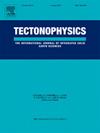Mixed-mode deformation in a rock bridge between two fault segments
IF 2.7
3区 地球科学
Q2 GEOCHEMISTRY & GEOPHYSICS
引用次数: 0
Abstract
Analyzing how fracture networks develop from preexisting isolated fault segments in immature faults may provide knowledge of the preparation process leading to fault growth and dynamic rupture. We reproduce this process experimentally using triaxial compression experiments coupled with time-lapse in-situ synchrotron X-ray tomography in Westerly granite core samples (10 mm diameter, 20 mm height) that contain two parallel notches oriented at 30° with respect to the axis of the cylinder. We conducted the experiments at room temperature with a constant confining pressure of 20 MPa. We image microfracture development, characterize the microphysical processes of damage and fault growth in an intact rock bridge between the notches, and analyze the evolution of fractures oriented at 0°–17° (extensile) and 17°–32° (shear) as the rock approached failure. We also elucidate the strain localization process in the deforming rock using digital volume correlation. Our study offers a detailed comparison of microfracture and strain field development during fault growth.
Results indicate that the rock bridge between the notches becomes damaged with a damage rate and a fracture rate diverging as the rock approaches macroscopic failure. Immediately preceding failure, shear fractures dominate the fracture networks. DVC analysis showed that the deformation process is mixed-mode, accommodated by dilation and shear strain, with the shear strains being more localized than the dilation. Furthermore, regions of high dilative strain host both extensile and shear fractures. These findings provide valuable insights into the fault growth process within an intact rock bridge between two fault segments in nature, demonstrating how mixed-mode deformation facilitates fault maturation.
两个断层段之间岩桥的混合模式变形
分析断裂网络如何从未成熟断层中先前存在的孤立断层段发展而来,可以提供导致断层生长和动态破裂的准备过程的知识。我们利用三轴压缩实验和延时原位同步加速器x射线断层扫描重现了这一过程,实验对象是Westerly花岗岩岩心样品(直径10毫米,高度20毫米),其中包含两个平行缺口,相对于圆柱体轴线方向为30°。实验在室温下进行,围压恒定为20 MPa。我们对微裂缝发育进行了成像,描述了缺口之间完整岩石桥中损伤和断层生长的微物理过程,并分析了岩石接近破坏时0°-17°(可拉伸)和17°-32°(剪切)方向裂缝的演化。我们还利用数字体积相关解释了变形岩石中的应变局部化过程。我们的研究提供了断层生长过程中微破裂和应变场发展的详细比较。
本文章由计算机程序翻译,如有差异,请以英文原文为准。
求助全文
约1分钟内获得全文
求助全文
来源期刊

Tectonophysics
地学-地球化学与地球物理
CiteScore
4.90
自引率
6.90%
发文量
300
审稿时长
6 months
期刊介绍:
The prime focus of Tectonophysics will be high-impact original research and reviews in the fields of kinematics, structure, composition, and dynamics of the solid arth at all scales. Tectonophysics particularly encourages submission of papers based on the integration of a multitude of geophysical, geological, geochemical, geodynamic, and geotectonic methods
 求助内容:
求助内容: 应助结果提醒方式:
应助结果提醒方式:


